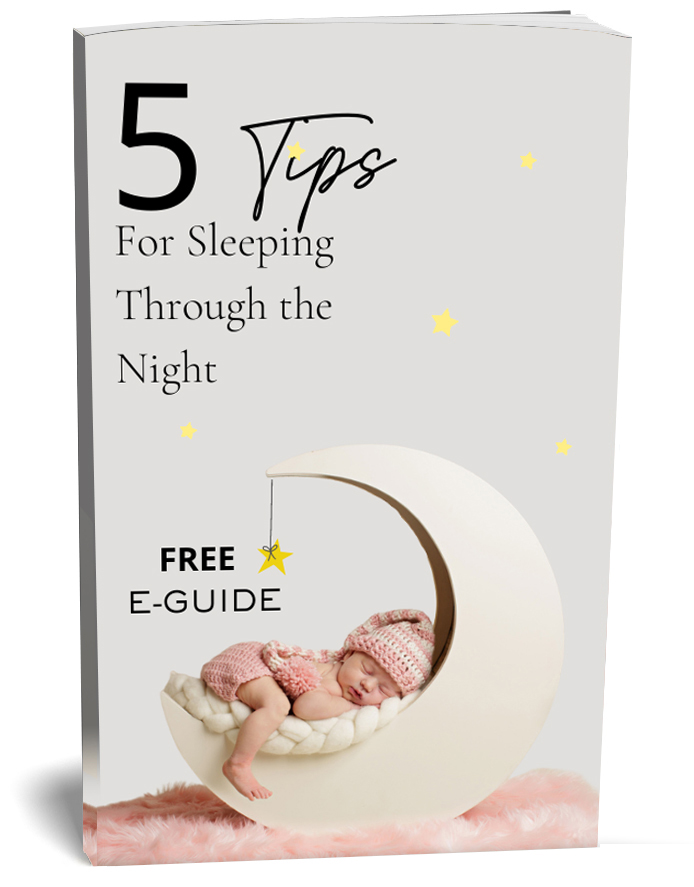
Wondering how to get your baby to sleep through the night?
“So… how much sleep are you getting?”
If you’re a new parent, you get this question all the time. The first few months of parenting can be rough — and everyone knows it.
And it’s even harder if your little one is having a hard time settling down at night. You can’t wait for the day when you’ll finally get a full night of sleep again. Even six hours would be amazing.
This is my complete guide to getting your baby to sleep through the night. I use these proven techniques with my clients to help the whole family get a great night’s sleep. If you don’t get these basics right, you could be in for a lot of sleepless nights.
Let’s get started.
1. Create a calming sleep environment
To help your baby get a great night’s sleep, creating a peaceful environment can make all the difference.
Be sure to keep the room as dark as possible. Darkness triggers the release of melatonin, a natural hormone that promotes sleep. Bright light causes the release of cortisol, signaling the body that it’s time to be awake and alert.
Blackout blinds are a great way to maintain a dark environment that’ll help your baby fall asleep. Choose lighting options that won’t disturb your baby’s sleep, like this cute moon nightlight.
If your baby often wakes up after you put her down, consider a white noise machine. They’re a great way to block out environmental noises like barking dogs. And studies have shown that most babies fall asleep faster in rooms with white noise.
Looking for flexible work options that can help you balance your career and personal life? Consider exploring the remote job opportunities listed on Jooble https://jooble.org/jobs-online-work-from-home
2. Set up a regular sleep schedule
One of the most important things you can do to ensure a great night’s sleep is to get your child on a regular sleep schedule.
The American Academy of Pediatrics recommends establishing a consistent sleep schedule for your baby. Get in the habit of getting up and going to bed at the same time every day. Each night, your little peanut will know when sleep is coming, and he’ll quickly adapt to the new routine.
Your baby’s sleep needs will change throughout the first year. You’ll find that you can put him down earlier and he’ll sleep for longer stretches as time goes on. Be flexible, and adapt with your little one as his needs change.
3. Establish a regular bedtime ritual
Creating a consistent bedtime ritual will help your baby get ready for sleep. Choose soothing activities that will help your baby get settled. For instance, you might give your little one a warm bath, read a story, or play some quiet music. Minimize stimulation.
Make your routine simple and easy to do, so you’ll be able to stay with it night after night. Using an app like the Bedtime app from Johnson’s can help you create a routine that sticks.
Once you’ve got your routine up and running, your bedtime ritual will create positive sleep associations… making it much easier for your little one to get settled.
4. Get the timing right
Now that you’ve got a regular sleep schedule set up and your evening ritual is on lock, it’s time for the most crucial part. Look for the signs that your baby is almost ready to fall asleep, but not quite there yet.
In short, you’re looking for the moment when your baby is drowsy but awake. That’s the right moment to put her down, so she can fall asleep on her own.

Drowsy but awake is a guideline, not an iron-clad rule. It means that when you put your baby down, she should be calm, comfortable, and ready to fall asleep on her own.
Odds are, sometimes when you put your little nugget down, she’ll start crying when you leave the nursery. Stay strong. A good rule of thumb is to allow ten minutes for your baby to settle herself down. You’re naturally primed to respond when your baby starts crying. But when you let her settle on her own, you’ll teach her a crucial life lesson: how to take care of herself.
5. Put your baby down earlier
If late-night wakings have been a struggle, you might be thinking you need to set a later bedtime. Get him really tired out and he’ll sleep all night, right?
Actually, it’s the other way around. By around the fourth month, most babies are ready for sleep as early as 7 pm… although your baby’s sleep needs will change throughout the first year. Wait too long, and you’ll have a cranky, fussy baby on your hands who can’t get settled.
Worried your kid will be up at the crack of dawn? Don’t stress. Most of the time, babies who go to bed at the right time sleep through the night and wake up refreshed.
Finding the right time may take a little experimentation. If your current bedtime is later in the evening, try setting it back 15 minutes. Keep setting it back every couple of days, always keeping an eye on how easily your baby falls asleep. Before long, you’ll be hitting that drowsy-but-awake sweet spot by early evening.
6. Never skip the afternoon naps
Regular afternoon naps are as important as early bedtimes. Especially during the first year, afternoon naps are essential for helping your baby recharge and refresh… so when bedtime rolls around, he’ll be easy to handle.
Setting up a consistent routine is the key to success. Look for signs of sleepiness, and always try to put him down drowsy but awake. Try simpler, shorter versions of your evening bedtime ritual to get naptime off to a smooth start.
Plan play dates and other activities around naptime to keep your routine on track. And don’t worry when life gets in the way. You’re driving back from running errands and get stuck in traffic for an hour on the freeway? No worries. Having a solid naptime routine in place will make it easy for you to get back on track tomorrow.

7. Avoid sleep props
We all have a nighttime routine to help us get to sleep. Whatever yours is, it helps you settle in for a great night of sleep.
And your baby is no different. If she’s a newborn, she may want you to hold her or rock her to sleep. But as she gets older, she’ll form other sleep associations. White noise, sucking on her fingers, a quiet lullaby… the possibilities are endless.
Some sleep associations are fine. If your baby is getting to sleep on her own — for example, by sucking on her fingers — it’s all good.
But some sleep associations aren’t healthy, because they depend on you. If your baby needs you to bounce her or sing to her to get to sleep, she can’t settle down without your help. And that means she still needs to learn a crucial skill: how to self-soothe.
If your baby is still depending on you, focus on the basics. Create a dark, calming nursery environment that will help her sleep. Set up a regular bedtime routine. And put your little one down drowsy but awake. It may not be easy — but you can teach her to sleep on her own.
8. Try dream feeding to reduce nighttime wakings
We all know what it’s like to wake up hangry. Jump out of bed, run to the kitchen, and scarf down the first thing you see. A whole box of Pop-Tarts. Cold pizza. A can of tuna. It doesn’t matter. Because you can’t sleep on an empty stomach.
And an empty tummy is one of the most common reasons why young babies wake up in the middle of the night, too. But there’s an easy way to eliminate nighttime hunger: dream feeding.
Dream feeding is a way to give your baby more calories late at night, so he can get a solid night’s sleep. Whenever you’re ready to turn in for the night, typically around 11 pm, get your baby out of the crib. But don’t fully wake him. Start nursing your baby, and he should start feeding even if he isn’t completely awake.
Is your baby waking up hungry, very early in the morning? Try an early-morning dream feed. Pay attention to the time when he usually starts crying, and start setting an alarm about a half-hour earlier. If he usually wakes up around 4 am, set an alarm for 3:30. If your baby still needs night feedings, by doing this, you’ll help him get comfortably through the night… without rewarding him for crying behavior. But be careful that you aren’t comfort feeding, this can actually contribute to sleep troubles and night wakings.
9. Skip the midnight diaper changes
You’ve heard it over and over again: “change the diaper after every feeding.” But what do you do when it’s 2 a.m. and you discover that your little peanut needs a diaper change?
If she’s just wet her diaper, it’s fine to let her sleep. Your baby’s diaper will wick away moisture so that she can continue sleeping. A midnight diaper change will only disrupt her sleep routine. Unless your baby’s diaper is completely soaked, she’s pooped, or she’s suffering from diaper rash, you’re better off letting her sleep.
And if you do need to do a midnight diaper change, get in and out like a ninja. Keep the room dark, move gently and purposefully, and try not to engage your little one.

10. Keep your expectations realistic
Be real with yourself. No matter what you do, your baby probably isn’t going to be sleeping twelve hours a night at two months. Know what typical baby sleep schedules look like so you’ll know what “sleeping through the night” looks like at every age.
And be flexible. The first year, you’ll experience a lot of ups and downs. Just when you think your baby has the sleeping-through-the-night thing down, the dreaded sleep regression kicks in. And you’re back to late nights in the nursery.
Highs and lows will happen throughout the first year. But if you’re ready to adapt as your baby’s needs change, it’ll go a lot more smoothly than you expect.
Your turn
The first year is a challenge — and if your little one isn’t sleeping, it’s even harder for everyone. But with these ten strategies, you can get your little peanut sleeping soundly through the night. And you can get the great night’s sleep you deserve, too.
Be sure to create a calming environment, set up a consistent bedtime ritual, and always put your little one down drowsy but awake.

And if you need more guidance, I’m here for you. I’ve helped thousands of families get the great night’s sleep they need, and I can help yours, too. Check out my sleep packages to learn more!





















